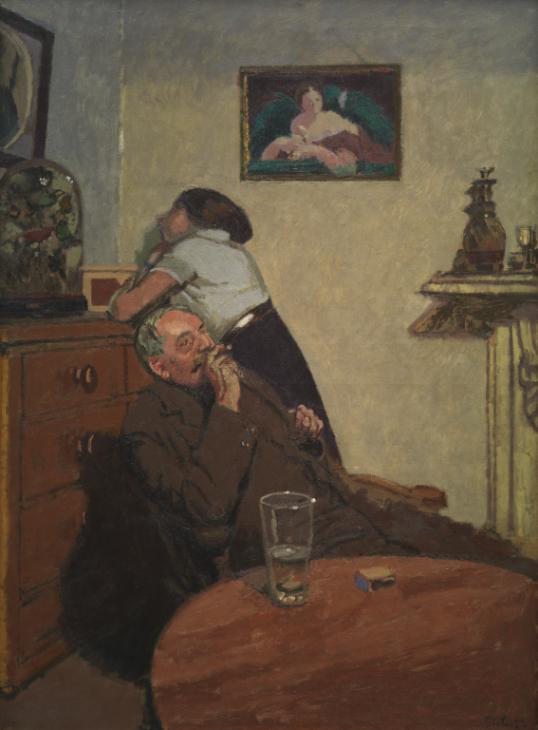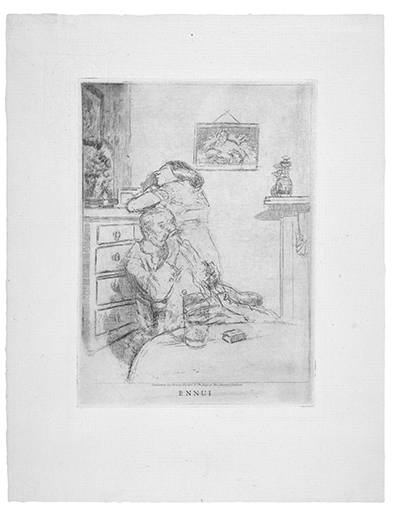Lettered below the image (centre) “Published by Ernest Brown & Phillips at The Leicester Galleries” and below titled “ENNUI”.
Watermark: Head of Christ and ‘1399’ below it.
Literature: Bromberg 156.VI
Provenance: Bonham’s Sale, Prints, 3 June 2008, lot 87.
Published in 1929 by the Leicester Galleries as an advertisement in the Artwork Quarterly Catalogue of Prints.
The French title of this domestic subject embodies its emotional state, where a man and woman from a low class look bored and alienated from each other.[1] Sickert’s models are his charlady, Mary Hayes, and his poor and alcoholic friend Hubby, probably represented in the artist’s studio in Granby Street, Camden Town.
 This
is Sickert’s most popular image, elaborated by the artist in several
preparatory drawings, five painted versions and three etched plates in
different sizes: large, medium and small.[2]
“The appearance and details of all three sizes of print are derived from Tate’s
version of Ennui, by way of a working drawing in pencil, pen and brown ink,
blue and red chalks (Whitworth Art Gallery, Manchester)”.[3]
The large plate was published in 1914 in the series printed by the Carfax Gallery.[4]
The medium plate, of which our etching is the final sixth state, was started by
Sickert in 1914-15, but finished only a few years later. Like the small plate, printed by Sylvia Gosse, the medium is also missing the glass on the
chimney piece on the right of the scene. Furthermore, compared to the other
images, both the characters’ faces of the medium plate are slightly more turned
toward the viewer.
This
is Sickert’s most popular image, elaborated by the artist in several
preparatory drawings, five painted versions and three etched plates in
different sizes: large, medium and small.[2]
“The appearance and details of all three sizes of print are derived from Tate’s
version of Ennui, by way of a working drawing in pencil, pen and brown ink,
blue and red chalks (Whitworth Art Gallery, Manchester)”.[3]
The large plate was published in 1914 in the series printed by the Carfax Gallery.[4]
The medium plate, of which our etching is the final sixth state, was started by
Sickert in 1914-15, but finished only a few years later. Like the small plate, printed by Sylvia Gosse, the medium is also missing the glass on the
chimney piece on the right of the scene. Furthermore, compared to the other
images, both the characters’ faces of the medium plate are slightly more turned
toward the viewer.
Sold
[1] The English translation of Ennui would be Boredom, but it doesn’t exactly match the nuances of the French word. Sickert – a skilled polyglot – was very careful with titling his works, resorting to other languages when English wasn’t enough, as in this case. See Nicola Moorby, ‘Ennui c.1914 by Walter Richard Sickert’, catalogue entry, May 2004, in Helena Bonett, Ysanne Holt, Jennifer Mundy (eds.), The Camden Town Group in Context, Tate Research Publication, May 2012, https://www.tate.org.uk/art/research-publications/camden-town-group/walter-richard-sickert-ennui-r1133434, accessed 14 June 2020.
[2] The most finished painting is dated c. 1914 and it is part of the Tate collections since 1924 due to its immediate success (N03846). See Moorby, ‘Ennui c.1914 by Walter Richard Sickert’, Tate, 2004.
[3] Nicola Moorby, ‘Ennui 1914–15, published 1929 by Walter Richard Sickert’, catalogue entry, May 2004, in op. cit. The Camden Town Group in Context, Tate, 2012.
[4] The series of sixteen etchings, mostly after Sickert’s earlier works, was part of the artist’s agreement with the Carfax Gallery as his solo dealer.
